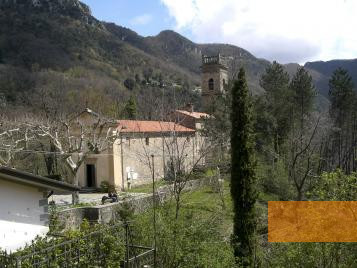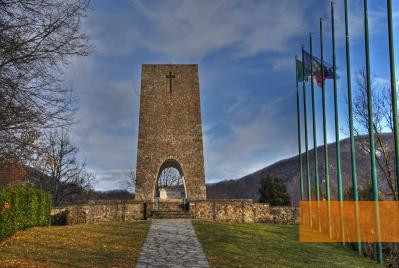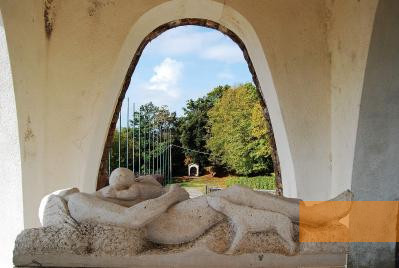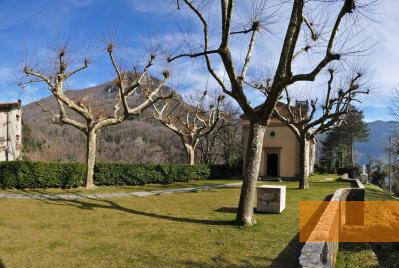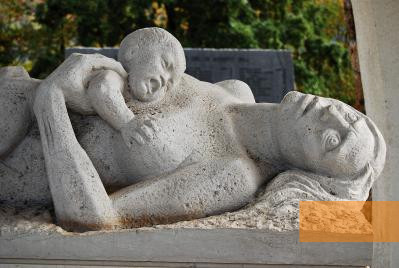On August 12, 1944, 560 civilians – mostly women, children and the elderly – were murdered in the Tuscan village of Sant'Anna di Stazzema. The village was subsequently destroyed. There are several memorials to the victims of the massacre: a museum, a monument and a »National Park of Peace«, which was opened in 2000.
In the summer of 1944, the front ran through the Tuscan coastal region of Versilia. Thousands fled the fighting by going to remote Alpine villages such as Sant’Anna di Stazzema, which could only be reached by small paths. The population of Sant’Anna di Stazzema went from 400 to 1,500. Although many partisans sought refuge in the Tuscan mountains, there is no evidence that there were any partisans in Sant’Anna di Stazzema. At the same time, the region was the site of numerous massacres committed against civilians by the 16th SS Panzergrenadier Division »Reichsführer SS« under the command of SS Gruppenführer Max Simon, under the pretext of »counter-partisan warfare«.
On the morning of August 12, four companies – about 300 soldiers – surrounded the village. The movement of troops didn't go unnoticed in the village, yet the residents assumed that this would be a routine police operation and they would be rounding up men who were fit for military service. In reaction, most of the able-bodied men fled to the woods while the women, children and the elderly remained. However, the SS carried out a massacre in Sant’Anna di Stazzema: up to 560 civilians were murdered by use of machine guns, hand grenades, flame throwers, and thrust weapons. The troops destroyed the church and many houses. They gathered the corpses on the church square and set fire to them.
On the morning of August 12, four companies – about 300 soldiers – surrounded the village. The movement of troops didn't go unnoticed in the village, yet the residents assumed that this would be a routine police operation and they would be rounding up men who were fit for military service. In reaction, most of the able-bodied men fled to the woods while the women, children and the elderly remained. However, the SS carried out a massacre in Sant’Anna di Stazzema: up to 560 civilians were murdered by use of machine guns, hand grenades, flame throwers, and thrust weapons. The troops destroyed the church and many houses. They gathered the corpses on the church square and set fire to them.
Tuscany is one of the Italian regions to be most affected by the violence and terror of the German occupying forces. Not only members of the SS, but also members of the Wehrmacht and the Luftwaffe committed over 280 massacres of the civilian population, especially between April and August 1944. 83 communities were affected, about 4,500 civilians were murdered. At least 10,000 people were deported to the German Reich to be deployed in forced labour. 560 people were murdered in Sant’Anna di Stazzema, mostly women, elderly people and children.
Directly after the war, the surviving residents of Sant’Anna di Stazzema were mainly concerned with rebuilding the village. In 1948, a first memorial site was dedicated, many more followed. A charnel house was built and the victims' remains laid to rest there. In 1965, the »Regional Centre of Resistance« (Italian: »Centro Regionale della Resistenza«) was established in Sant’Anna di Stazzema. In 1982, a collection of paintings was added, and in 1991, the institution was expanded into the »Historical Museum of Resistance«. In 2000, a park of peace was opened; its aim is to support international peace initiatives.
In 2007, an »organ of peace« was unveiled in the village church thanks to donations from Germany and Italy. The judicial dealing with the massacre has not yet been completed, however. Though Max Simon was convicted of the crimes committed in Sant’Anna and sentenced to death in 1948, his sentence was later commuted to life imprisonment. Other perpetrators were not subjected to prosecution until the 1990s because German war crimes in Italy were not investigated much during the Cold War out of consideration for Italy's and West Germany's membership in the NATO alliance. The military prosecution only discovered the so-called »cabinet of shame« in 1994 – an archive on German war crimes that had been kept locked up since 1960. The evidence made it possible for ten perpetrators of the massacre at Sant’Anna to be investigated and sentenced to life imprisonment in their absence. However, they did not have to serve their sentences as the constitution of the Federal Republic of Germany does not allow the extradition of German citizens. In 2002, the prosecution in Stuttgart began investigating several suspected perpetrators on its own accord. The investigations were dropped in October 2012 citing lack of evidence.
In 2007, an »organ of peace« was unveiled in the village church thanks to donations from Germany and Italy. The judicial dealing with the massacre has not yet been completed, however. Though Max Simon was convicted of the crimes committed in Sant’Anna and sentenced to death in 1948, his sentence was later commuted to life imprisonment. Other perpetrators were not subjected to prosecution until the 1990s because German war crimes in Italy were not investigated much during the Cold War out of consideration for Italy's and West Germany's membership in the NATO alliance. The military prosecution only discovered the so-called »cabinet of shame« in 1994 – an archive on German war crimes that had been kept locked up since 1960. The evidence made it possible for ten perpetrators of the massacre at Sant’Anna to be investigated and sentenced to life imprisonment in their absence. However, they did not have to serve their sentences as the constitution of the Federal Republic of Germany does not allow the extradition of German citizens. In 2002, the prosecution in Stuttgart began investigating several suspected perpetrators on its own accord. The investigations were dropped in October 2012 citing lack of evidence.
- Name
- Museo Storico della Resistenza / Parco Nazionale della Pace
- Address
-
Via Coletti 22
55041 Sant’Anna di Stazzema - Phone
- +39 0584 772 025
- Fax
- +39 0584 772 025
- Web
- http://www.santannadistazzema.org/
- santannamuseo@comune.stazzema.lu.it
- Open
- Museum: October to May Tuesday and Wednesday 9 a.m. to 2 p.m., Thursday to Saturday 9 a.m. to 5.30 p.m., Sunday 2.30 p.m. to 6 p.m.
June to September Tuesday and Wednesday 9 a.m. to 2 p.m., Thursday to Saturday 9.30 a.m. to 6 p.m., Sunday 3 p.m. to 6.30 p.m.
The park is accessible at all times. - Possibilities
- Permanent exhibition, film productions, film collection, guided tours, meetings with survivors, youth meetings


